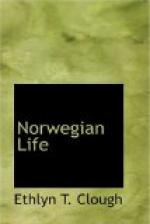A little west of Gefle is the town of Fahlun, which is the headquarters of the Kopparberg Mining Company, the, oldest industrial corporation in the world. The buildings date back to the seventeenth century and the mines are even more ancient. A mortgage bond was filed upon them in the year 1288 by a German company, and the records show that in 1347 the privilege of working them was sold by the king of Sweden to a syndicate of Lubeck miners. But these documents which are on file in the archives of the town are comparatively modern, because the copper deposits at Fahlun were known and worked in prehistoric times, and from them the Vikings obtained the sheathings for their ships and the material from which their copper armor, implements, and utensils were made. An immense amount of copper was used and worked with great skill in Scandinavia even before the Christian era, and the most of it came from the great deposits at Fahlun.
The iron industry is old in Sweden. Isaac Breant, a tradesman in Stockholm, founded a company and received a charter from Charles XI in 1685. He built the first blast furnace in Sweden, and died in 1702, leaving the property to his son, who died in 1720. The heirs sold out in 1722 to a man named Grill, in whose family the property remained until 1800, when it was purchased by the ancestors of the present owners.
The famous Dannemora mines, which produce the best Bessemer ore in the world, have been worked continuously since 1481. It is one of the most valuable and extensive iron deposits in the world, and resembles those of Lake Superior. The area of ore already located covers 12,500 square meters.[m]
CHAPTER XIV
HIGHWAYS, RAILWAYS, AND WATERWAYS
Since the sixteenth century Norway has had an excellent public posting system which enables the traveler to go to the most remote parts of the country at moderate and fixed rates. Fast and slow posting stations are established by the government along all the national highways. At the former, horses must be kept in readiness; whereas, at the latter, the horses may be in distant fields at work, and a couple of hours may elapse before the traveler can proceed upon his journey. The rates, which are determined by the government, are, from fast stations, about seven cents a mile for a horse and two-wheeled conveyance or sledge; but from slow stations they are scarcely more than half that price. When the road is over very steep mountains, an extra fare is charged, usually double; but this is a government regulation and is always understood. The posting stations are, for the most part, isolated and solitary farms. The farmers undertake to provide rooms and meals, as well as drivers, horses, and conveyances. Stations are usually from seven to fifteen miles apart, and farmers are required to convey the traveler only as far as the next station.




